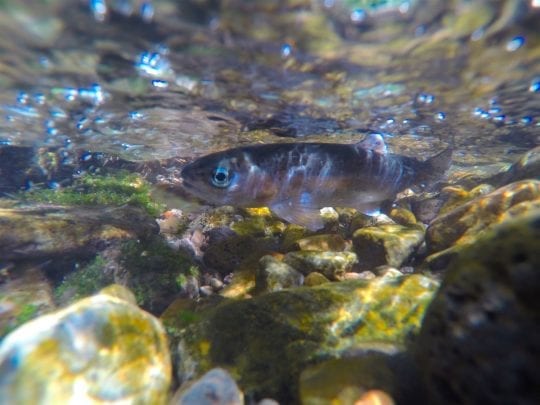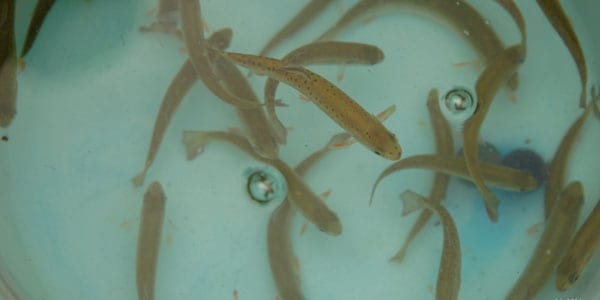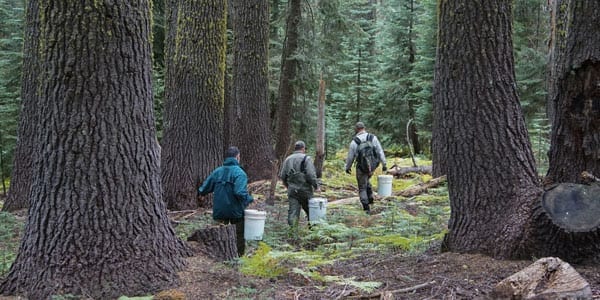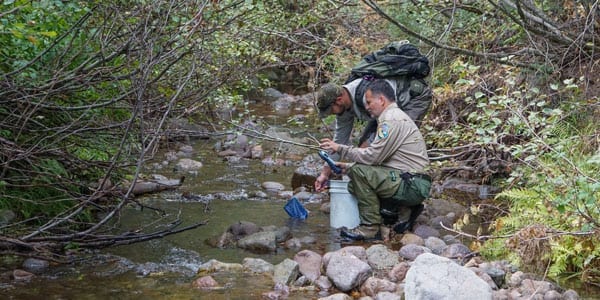McCloud Redband Reintroduction
McCloud River trout are arguably one of the most famous fish in the world. In the early 1870’s rainbow trout from the lower McCloud were taken into a newly built hatchery and transplanted all around the world. Rainbow trout are now on every continent and in just about every mountain range and many have some lineage to original McCloud River rainbow.
Technically speaking, there are two different, genetically distinct types of McCloud River rainbow trout. Trout that lived below the Middle Falls of the McCloud River, an impassable fish barrier, are genetically classified as coastal rainbows. For thousands of years they have been subjected to genetic drift from other populations of rainbows in the form of steelhead. Before Shasta and McCloud dams were built in 1945 and 1965, respectively, steelhead from as far south as the Central Valley and as far north as the Columbia River migrated up the McCloud River. These rainbows share a genetic resemblance to all coastal rainbows and steelhead that have access to the ocean throughout California.

The trout from above the impassable Middle Falls of the McCloud River have been genetically isolated for thousands of years and have evolved into their own distinct fish know as McCloud River redband trout. They are thought to be one of the oldest populations of rainbow trout, called the proto rainbow by some fish biologists. Historically, the range for these unique fish was the upper reaches of the McCloud River system and a few small creeks along the east flanks of Mount Shasta, where the fish have remained isolated for centuries.
Following the turn of the century, fish from the lower river and other strains of rainbow trout had been stocked into the upper McCloud for angling opportunities. Those fish spread throughout the upper basin and readily hyrbidized with McCloud River redband trout, diluting the gene pool. Only a few very small isolated populations of fish survived, unaltered by non-native genetics. After genetic testing by UC Davis and others, these small fragmented populations were identified and eventually became listed by the state as threatened due to the sensitivity of their habitat and the densities of these small populations. These small vestiges of native fish have been monitored and protected for a few decades.
Fish in Peril
The true, pure strain McCloud River redband trout were hit especially hard by the California drought. The creeks that hold pure strain McCloud redband are disconnected from the mainstem McCloud River. These small creeks well up from springs and only flow for a mile or two before going sub-surface again. Due to the nature of the habitats and how they swell with the spring runoff then dry up and become disconnected in the summer, there is always some level of mortality on a few of these creeks. However, in 2013, DFW biologists noticed conditions were reaching critical levels for fish in a large portion of the available habitat. In late summer, dissolved oxygen levels were getting low and temperatures were rising. In the winter, the small creeks are subject to freezing if the water levels and flow are too low. After careful consideration, the hard decision was made to bring some of these fish into captivity to reduce mortality and potentially lose important meta populations in the wild.
The drought continues to be devastating on the populations of these important fish. If we did not take action to save them during the summers, small, independent populations may have succumbed. Our proactive rescue efforts will help maintain this unique species for the future.”
Andrew Jensen, a biologist with CDFW’s Northern Region Inland Fisheries Program
DFW to the Rescue
Fortunately, the DFW has a hatchery facility nearby in the town of Mount Shasta that is run off very cold spring source water, much like the McCloud River redband are used to in their natal streams. A portion of the facility was equipped with a state of the art self-contained Recirculating Aquaculture Systems (RAS). Fish captured from the wild were kept separate in their distinct family groups from each individual stream and treated different than typical hatchery raised fish that are to be released for sport. To keep the McCloud River redband as “wild” as possible, handling was kept at a minimum to avoid association with humans and food and they were fed natural insects to while in the hatchery facility.

Some fish populations were in captivity for over two years. These fish were bred twice, once each year, and produced two generations of offspring while at the hatchery. Genetic testing was done on each fish and they were then cross-bred according to a genetic matrix on a paper drafted by UC Davis to increase genetic diversity while maintaining the purest genetic makeup of the different family groups and meta populations.
Returning Home
Luckily for the McCloud River redband, the winter of 2016 brought above average precipitation and conditions in the creeks improved greatly. Continued monitoring of the creeks have yielded favorable data. That along with projected weather forecasts led to the decision to begin releasing most of the fish back into the wild to their home waters.

Earlier this month, crews from the Department’s Inland Fisheries Division, the Mount Shasta Hatchery, and the Wild Trout program came together to carry out the reintroduction process. This effort was led by Heritage and Wild Trout Program biologist Mike Dege. A week before being released each fish was equipped with a PIT tag, which will allow the DFW to track fish movements and survival rates.
Each day they picked a different creek and went about releasing the different populations of fish back into the habitats from which they were rescued two years earlier. It was a meticulous process with each fish scanned, catalogued and GPS coordinates marked where they were released. Close to a thousand fish were released back into the wild. Some of these fish were the original rescued fish and some of them were the juvenile fish that were bred in the hatchery. Care was taken to release the fish back into the same stretches of creek from which they were rescued. The same family groups were released back into their natal creeks and a 10% addition of fish from the neighboring creeks were added to each system to ensure genetic health for the long term viability of the species.
Over the past few days the reintroduction has gone well. Conditions in the creeks were about what we expected. We have experienced very low mortality rates and the fish seem to be taking well to the natural habitat. Over the course of the next few months, we will continue to monitor the fish to make sure they can transition safely into the winter months.”
DFW field biologist, Mike Dege

It is stories like this of the McCloud River redband trout that underscore the severity of drought in California and its lasting effects on our native fish populations and coldwater ecosystems. It also demonstrates the importance of our mission to ensuring California will always have resilient wild fish thriving in healthy waters.
Michael Wier
California Trout





2 Comments
This is so awesome. Thank you for all your hard work and dedication to preserve this natural treasure for future generations!
Maybe to should look into the California Heritage Trout Challenge. You would “Live” awesome!